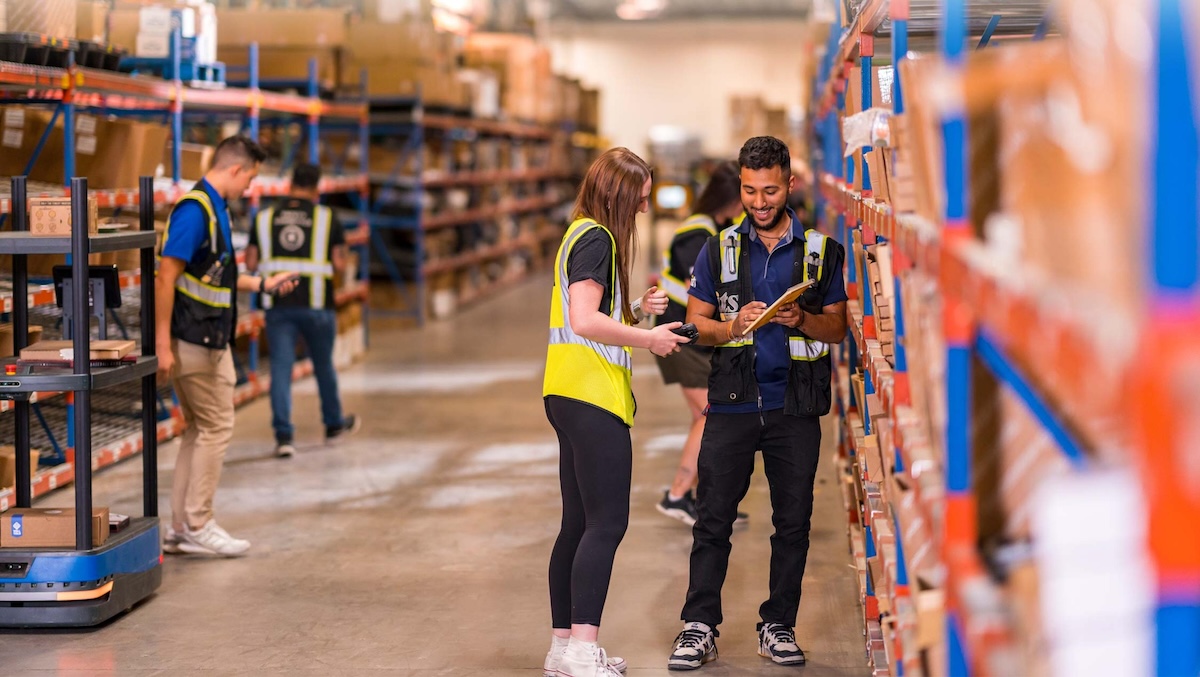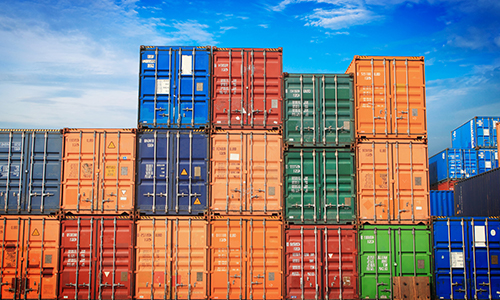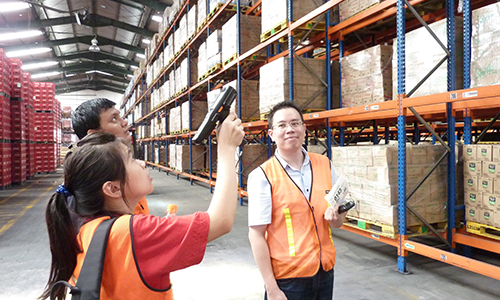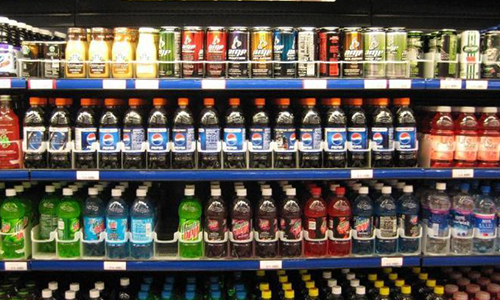Warehouse Management in Manufacturing Industry
[vc_row row_scroll_icon="no"][vc_column][vc_empty_space height="24px"][vc_column_text css=""]PS: Bahasa Indonesia version of this article available below[/vc_column_text][vc_empty_space][vc_column_text css=""] Introduction Warehouse management in the manufacturing industry is a critical component of the overall production process. Efficient warehouse management ensures that raw materials and finished goods are available at the right time and place, minimizing production delays and optimizing inventory levels. This article explores the essential aspects of warehouse management in the manufacturing sector and highlights the specific areas where warehouse management systems (WMS) can be utilized.[/vc_column_text][vc_empty_space][vc_column_text css=""] Manufacturing Warehouses Manufacturing warehouses in general will have a few main functions:[/vc_column_text][vc_empty_space height="24px"][vc_row_inner][vc_column_inner width="1/3"][vc_column_text css=""] Raw-Material Warehouse [/vc_column_text][vc_single_image image="6045" img_size="medium" css=""][vc_empty_space][vc_column_text css=""]This warehouse stores materials needed to perform production process, which are the raw materials (RM) as well as packaging materials (PM). WMS will automate end-to-end materials movement from incoming goods from suppliers, quality process to picking for production based on material requests from PPIC or floor operators.[/vc_column_text][/vc_column_inner][vc_column_inner width="1/3"][vc_column_text css=""] Finished-Goods Warehouse [/vc_column_text][vc_single_image image="6044" img_size="medium" css=""][vc_empty_space][vc_column_text css=""]All finished items from productions will be passed over to this warehouse for stocking and distribute to customers, branches or other warehouses based on orders WMS will keep track of expired dates, batches and give recommendations to achieve effective operations in the warehouse, eliminating probability of expired products as well as sending wrong products to the wrong destinations.[/vc_column_text][/vc_column_inner][vc_column_inner width="1/3"][vc_column_text css=""] Parts Warehouse [/vc_column_text][vc_single_image image="6046" img_size="medium" css=""][vc_empty_space][vc_column_text css=""]This warehouse will keep spare parts, tools and components for factory machinery usage. The parts will be dispensed based on request by floor technicians / mechanics to ensure production machineries are running well WMS may help in keeping track of all the parts from incoming parts to dispensing parts. There is also more control over parts requests, who often requests and how often a certain part being used.[/vc_column_text][/vc_column_inner][/vc_row_inner][vc_empty_space height="24px"][vc_column_text css=""]Areas Where Warehouse Management Systems Can Be Used Receiving and Inspection A WMS can automate the receiving process, using barcode scanners and RFID technology to verify shipments against purchase orders (or production orders for Finished Goods warehouses). This ensures that the correct materials are received and that any discrepancies are identified and resolved quickly. Storage Optimization WMS can help optimize the layout of the warehouse by determining the best storage locations for materials based on their usage frequency and size. This reduces retrieval times and maximizes storage space. Automated storage and retrieval systems (AS/RS) can further enhance efficiency by automating the placement and retrieval of items. Inventory Management Real-time inventory tracking provided by a WMS ensures accurate stock...
Warehouse Management in Retail
[vc_row row_scroll_icon="no"][vc_column][vc_empty_space height="24px"][vc_column_text css=""]PS: Bahasa Indonesia version of this article available below[/vc_column_text][vc_empty_space height="24px"][vc_single_image image="5986" img_size="full" css=""][vc_empty_space][vc_column_text css=""] Introduction In the dynamic world of retail, efficient warehouse management is critical for ensuring timely delivery, inventory accuracy, and overall customer satisfaction. Retail distribution centers (DCs) serve as the nerve centers for the supply chain, bridging the gap between suppliers, retail store branches and even online consumers. Effective warehouse management in these centers requires addressing specific requirements unique to the retail industry.[/vc_column_text][vc_empty_space][vc_column_text css=""] Key Functions of WMS in Retail Distribution Centers [/vc_column_text][vc_empty_space height="24px"][vc_single_image image="6011" img_size="full" alignment="center" css=""][vc_empty_space height="24px"][vc_column_text css=""]Retail distribution centers perform several essential functions: Receiving and Inspection: Ensuring that incoming goods match orders and are in good condition. Storage: Organizing products in a way that maximizes space and facilitates easy retrieval with pick-face management. Inventory Management: Keeping accurate records of stock levels and locations. Order Picking: Selecting products to fulfill store branch orders accurately and efficiently. Packing and Shipping: Preparing orders for dispatch and ensuring they reach store branches in good condition. Proof-of-Delivery: Ensure correct shipment is well-received by store branches. [/vc_column_text][vc_empty_space][vc_column_text css=""] Typical Priorities for Retail Warehouse Management High Turnover and Seasonal Variability Challenge: Retailers often deal with a high turnover of inventory, with frequent changes in product lines due to seasonality, trends, and promotions. Solution: Implementing flexible warehouse systems that can quickly adapt to changing inventory levels and patterns is crucial. This includes scalable storage solutions and dynamic workforce management to handle peak seasons efficiently. Inventory Accuracy and Visibility Challenge: Retail businesses need precise inventory data to avoid stockouts or overstock situations. Solution: Utilizing advanced inventory management systems with real-time tracking capabilities ensures accurate stock levels. Technologies such as RFID and barcode scanning can enhance visibility and traceability throughout the warehouse. Even more advanced WMS will power the capability of predicting demand and inventory trend further with AI. Efficient Order Fulfillment for Store Branches Challenge: Retail stores require timely and accurate delivery of products to maintain stock levels and meet customer demands. Solution: Implementing smart picking systems can significantly speed up the order fulfillment process. Additionally, integrating warehouse management systems (WMS) with order management systems (OMS) ensures seamless processing of orders from receipt to dispatch. Space Optimization Challenge: Maximizing warehouse space is critical in retail, where a wide variety of products need to be stored. Solution: Utilizing vertical space with high-density shelving and implementing slotting optimization strategies can improve storage efficiency. Regularly...
Penggunaan Barcode di Gudang (Warehouse / Distribution Center)
[vc_row row_scroll_icon="no"][vc_column][vc_empty_space][vc_column_text] Link: Mengapa Butuh Barcode di Gudang? Aplikasi WMS untuk Gudang Apa Yang Harus Dipersiapkan Untuk Menggunakan WMS? Butuh Konsultasi / Presentasi? [/vc_column_text][eltd_separator type="full-width"][/vc_column][/vc_row][vc_row row_scroll_icon="no" el_id="1"][vc_column][vc_empty_space][eltd_section_title title="Mengapa Butuh Barcode di Gudang?" title_color="" title_text_transform="" title_text_align="" margin_bottom="" title_size="small"][vc_empty_space height="20px"][vc_column_text] Penggunaan barcode di sudah biasa kita temukan di produk-produk yang setiap hari kita gunakan, dari alat-alat rumah tangga, makanan, minuman sampai ke alat-alat industri. Bentuk barcode-nya juga bisa berupa barcode 1D (1 dimensi) yang berupa garis-garis maupun berbentuk barcode 2D (2 dimensi) seperti QR-code yang paling umum. Meskipun produk/barang sudah mempunyai barcode bawaan, tetapi belum tentu dapat digunakan di area Gudang. Fungsi gudang seperti Gudang Bahan Baku Produksi, Gudang Barang Jadi Produksi, Gudang Distribusi (Distribution Center), dan Gudang Logistik biasanya membutuhkan pemakaian Barcode yang khusus untuk gudang. Ingin tahu lebih jauh lagi mengenai Barcode Gudang dan bedanya dengan Barcode produk? Silahkan disimak video berikut ini: [/vc_column_text][vc_empty_space][vc_video link="https://youtu.be/JBafOxSlL7I" align="center" css=""][vc_empty_space][eltd_separator type="full-width"][/vc_column][/vc_row][vc_row row_scroll_icon="no" el_id="2"][vc_column][vc_empty_space][eltd_section_title title="Aplikasi WMS Untuk Gudang" title_color="" title_text_transform="" title_text_align="" margin_bottom="" title_size="small"][vc_empty_space height="20px"][vc_column_text] Barcode Gudang (atau Barcode LPN) biasanya dapat dicetak sendiri secara manual maupun secara otomatis dari sistem WMS (Warehouse Management System). Kami menyarankan penggunaan sistem aplikasi WMS karena pencatatan berdasarkan Barcode Gudang yang sudah tercatat secara digital yang akan membantu meminimalisir kesalahan manusia (human error) secara signifikan. Pertanyaannya adalah: Kapan saatnya mulai menggunakan WMS? Dalam hal ini ada beberapa point indikasi perusahaan Anda sudah membutuhkan aplikasi WMS: Perlu mencatat Batch, Lot dan/atau Expired Date serta memanfaatkan informasi tsb untuk pengeluaran barang berdasarkan FIFO/FEFO dan Shelf Life Kesulitan mengetahui dengan pasti untuk stok barang-barang yang terlanjur ataupun hampir kadaluarsa Sering terjadi kesalahan pengiriman barang, baik salah barang maupun salah tujuan Persiapan yang panjang setiap kalinya untuk melakukan stock opname dan itupun hasilnya kurang akurat setiap kalinya Tidak mengetahui performa atau produktivitas operator Gudang secara lebih pasti Silahkan simak video paparan lengkap mengenai isu-isu di atas untuk Anda yang ingin tahu lebih detail: [/vc_column_text][vc_empty_space][vc_video link="https://youtu.be/ell_5wk_XTQ" align="center" css=""][vc_empty_space][eltd_separator type="full-width"][/vc_column][/vc_row][vc_row row_scroll_icon="no" el_id="3"][vc_column][vc_empty_space][eltd_section_title title="Apa Yang Harus Dipersiapkan Untuk Menggunakan WMS?" title_color="" title_text_transform="" title_text_align="" margin_bottom="" title_size="small"][vc_empty_space height="20px"][vc_column_text] Largo WMS telah digunakan oleh perusahaan-perusahaan ternama nasional dan terbukti efektif menjawab isu-isu di atas yang memang umum terjadi di Gudang. Untuk dapat meng-implementasikan Largo WMS, Anda perlu mempersiapkan beberapa hal sebagai berikut: [/vc_column_text][vc_empty_space][vc_column_text] 1. Rugged Mobile Computer dan Barcode Printer [/vc_column_text][vc_row_inner content_aligment="center" css=".vc_custom_1649054511791{padding-top: 10px !important;padding-right: 10px !important;padding-bottom: 10px !important;padding-left: 50px !important;}"][vc_column_inner width="2/3"][vc_column_text] Yang paling utama, Anda akan membutuhkan Barcode Printer (pencetak label barcode) dan Rugged Mobile Computer (Barcode Scanner dgn OS Android). Kami merekomendasikan penggunaan produk dari Zebra Technologies karena memang didesain dan sudah teruji untuk...
How long to implement a WMS System?
[vc_row row_scroll_icon="no"][vc_column][vc_empty_space height="24px"][vc_column_text]Implementing warehouse management system requires several steps to ensure its success. It's not just the system as the system usually is ready to be deployed within days. The other requirement however, requires more time to prepare. Let's break it down. Gap Development The first step of WMS implementation is to get a gap analysis between LARGO and your existing business process. We need to make sure everything is covered and ensure the flow from start to finish. This process usually involves warehouse team, finance, IT, ERP consultant and management. This step usually take around 2 - 8 weeks to complete. Hardware Purchase We also need several hardware to support WMS project such as Server, Wireless Network, Mobile Computers and Barcode Printers. Some of these thing requires 8 - 10 weeks to purchase and install, so please be prepare to factor in these into your timeline. Integration, Data Migration and Data Sanitation IF you need to connect WMS with your ERP or eCommerce system, then we will need to have an integration work together with your ERP consultant. This job including Blue Print / design, development, testing and go live. We also need to migrate some data from your existing system, such as master files, tables, etc. Sometimes, existing data also requires a sanitation process to remove unwanted/unused data. This process can take up to 4 - 8 weeks as well. Warehouse Preparation Items in the warehouse needs to be re-labeled and re-registered to the new system. Each bin location also must be labeled. Depending on the number of stock in the warehouse, this process can take up to 4 - 8 weeks as well. Training Once everything is ready, we need to train every stakeholders in the company which can take up to 1 week for both classroom training and field training. After the training, we take the system to Go Live! So the conclusion, to implement LARGO Warehouse Management System, we needs around 2 - 4 months to complete. Contact our team to discuss more on the timeline and what are the thing you need to prepare before implementing WMS.[/vc_column_text][/vc_column][/vc_row]...
Choosing the Right Mobile Computer for WMS
[vc_row row_scroll_icon="no"][vc_column][vc_empty_space height="24px"][vc_column_text]Mobile Computer or some call it PDT, HHT, RF, Handheld...
Existing Barcode vs New Barcode
[vc_row row_scroll_icon="no"][vc_column][vc_empty_space height="24px"][vc_column_text]We often come across question from our client "Can we use our existing barcode on the product in the warehouse" ? Well, the simple rule in the warehouse is that we need a UNIQUE barcode for each unit of measurement which can be a carton or a pallet. This unique barcode will help us to identify individual FIFO, expiry date, batch, production number and other important information. Product barcode is usually NOT UNIQUE. It means, for every Coca-Cola can, the barcode will all be the same. And don't forget that this barcode lays on item level, which is rarely the case for warehouse operation. That's why, when a product comes in to the warehouse, during Tally process, we put a new unique barcode for each carton or pallet. The barcode then will be associated with information required so now every carton or pallet has a unique information attached to its barcode. This information will continue being updated along the way during every warehouse operation such as put away, picking, stock take and delivery. If you have a unique case or need to discuss how to use barcode in your warehouse, let us know and we will be very happy to help.[/vc_column_text][/vc_column][/vc_row]...








